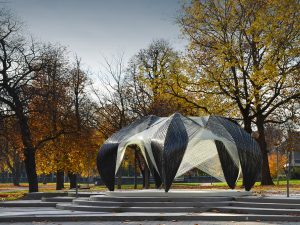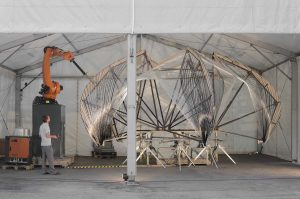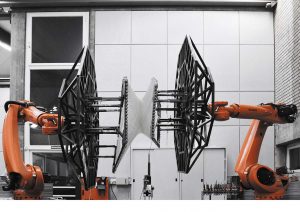INTRODUCTION TO CORELESS FILAMENT WINDING
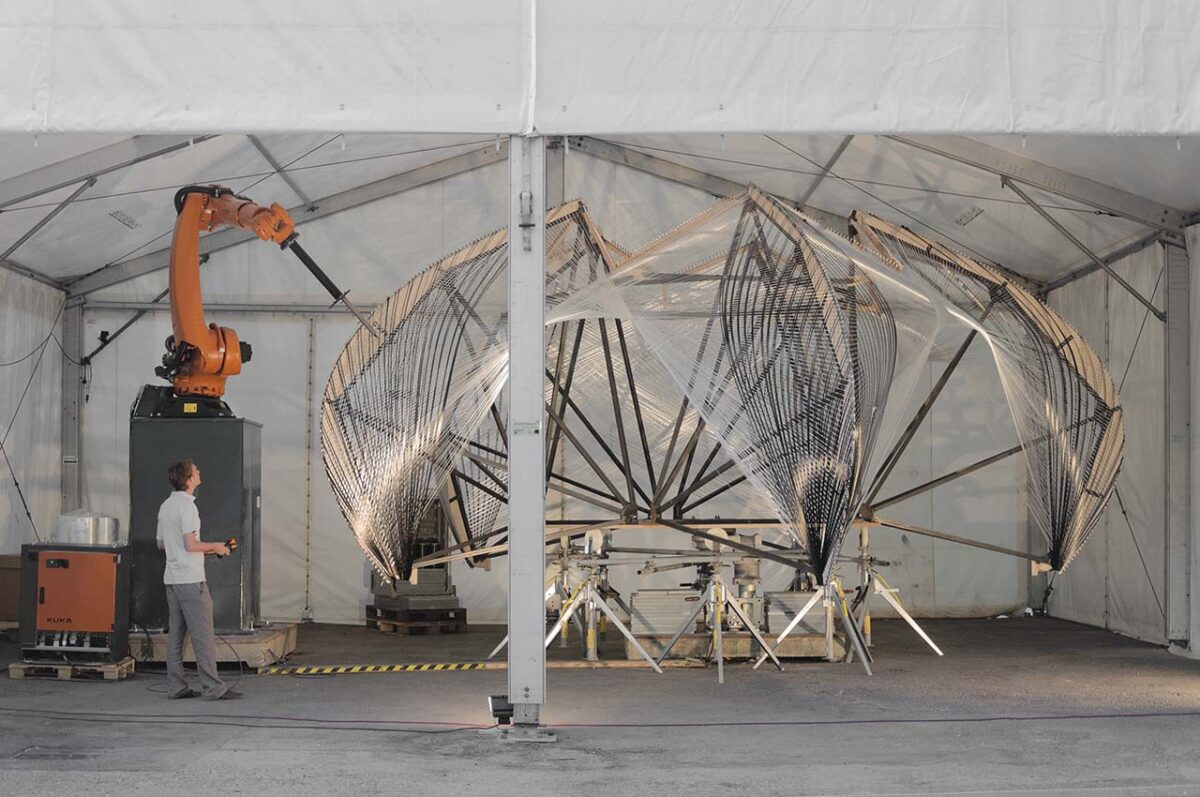
ESR08- Virtual Prototyping FRP
AUTHOR: JAMES SOLLY
There are a multitude of forming processes available for the fabrication of Fibre-Reinforced Polymer (FRP) components, from simple hand lay-ups to heavily automated industrial processes.
“Coreless Filament Winding” is a variation on typing filament winding methods that has been jointly developed by Innochain Partner the Institute of Building Structures and Structural Design (itke) and the Institute of Computational Design (ICD) over the last 4 years.
Since research into the process began in 2004, three projects have been successfully realised using coreless winding: the ICD/ITKE Research Pavilion 2012 (based on the fibre arrangement in a Lobster claw), the ICD/ITKE Research Pavilion 2013/2014 (based on the fibre arrangement found in a beetle Elytra) and the Unversity of Stuttgart Hannover Fair Stand 2015.
The process relies upon the use of a discrete, minimal framework that continuous glass and fibre rovings are wrapped around in a pre-determined sequence by an industrial robot. The fibres interact in the space between the frame elements, forming a curved surface of varying density (between sparse mesh and continuous shell).
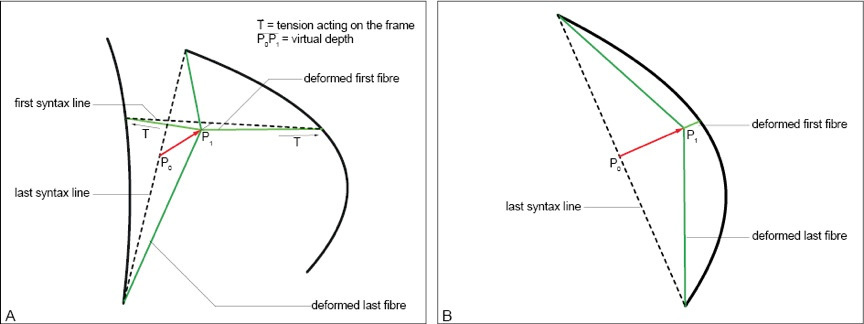

The use of fibre interactions to create geometry means that fibre direction, tension and placement sequence are inherently linked with the final form achieved. Additionally, the anisotropic nature of FRP means that stiffness and load-bearing capacity are also directly coupled to the fabrication methodology.
This interlinking of properties means that consideration of all aspects of the proposed structure performance and fabrication must be considered at the initial stages of concept design. Currently this is achieved through an aligned study involving scale models, measurements from these and simplified structural simulations that are later updated and benchmarked by larger-scale physical prototyping. The starting point of this research has been in the consideration that an easy-to-apply virtual prototyping strategy would reduce the time required for early-stage design iterations and ensure that more complex modelling and analysis later in the process may be based on a buildable form.
REFERENCES
- Dörstelmann, M., Parascho, S., Prado, M., Menges, A., Knippers, J., 2014. Integrative Computational Design Methodologies for Modular Architectural Fiber Composite Morphologies, in: Acadia 2014. pp. 219–228.
- La Magna, R., Waimer, F., Knippers, J., 2014. Coreless Winding – A novel fabricaton approach for FRP based components in building construction. Proc. 7th Int. Conf. FRP Compos. Civ. Eng. (CICE 2014) 1–6.
- La Magna, R., Reichert, S., Schwinn, T., Waimer, F., Knippers, J., Menges, A., 2013. Prototyping Biomimetic Structures for Architecture. Proc. Prototyp. Archit. Conf. 224–244.
- Parascho, S., Knippers, J., Moritz, D., Prado, M., Menges, A., Dörstelmann, M., Prado, M., Menges, A., Krieg, O.D., 2014. Modular Fibrous Morphologies: Computational Design, Simulation and Fabrication of Differentiated Fibre Composite Building Components. Adv. Archit. Geom. 2014 109 – 125.
- Prado, M., Schwinn, T., Menges, A., Knippers, J., 2014. Core-Less Filament Winding, in: Robotic Fabrication in Architecture, Art and Design. pp. 275–289.
- Reichert, S., Schwinn, T., La Magna, R., Waimer, F., Knippers, J., Menges, A., 2014. Fibrous Structures: An Integrative Approach to Design Computation, Simulation and Fabrication for Lightweight, Glass and Carbon Fibre Composite Structures in Architecture based on Biomimetic Design Principles. Comput. Des. 52, 27–39.
- Schloz, M., Weigele, J., Schwinn, T., Reichert, S., La Magna, R., Waimer, F., Knippers, J., Menges, A., 2013. Fibrous Morphologies: Integrative design and implementation of robotic filament winding in architecture, in: eCAADe 31. pp. 549–558.
- Van de Kamp, T., Dörstelmann, M., Dos Santos Rolo, T., Baumbach, T., Menges, A., Knippers, J., 2015. Beetle elytra as role models for lightweight building construction Beetle Elytra as Role Models. Entomol. heute 27, 149–158.
- Waimer, F., La Magna, R., Knippers, J., 2013a. Integrative numerical techniques for fibre reinforced polymers – Forming process and analysis of differentiated anisotropy. J. Int. Assoc. Shell Spat. Struct. 54, 301–309.
- Waimer, F., La Magna, R., Reichert, S., Schwinn, T., Menges, A., Knippers, J., 2013b. Integrated design methods for the simulation of fibre-based structures. Des. Model. Symp. 1–9.

